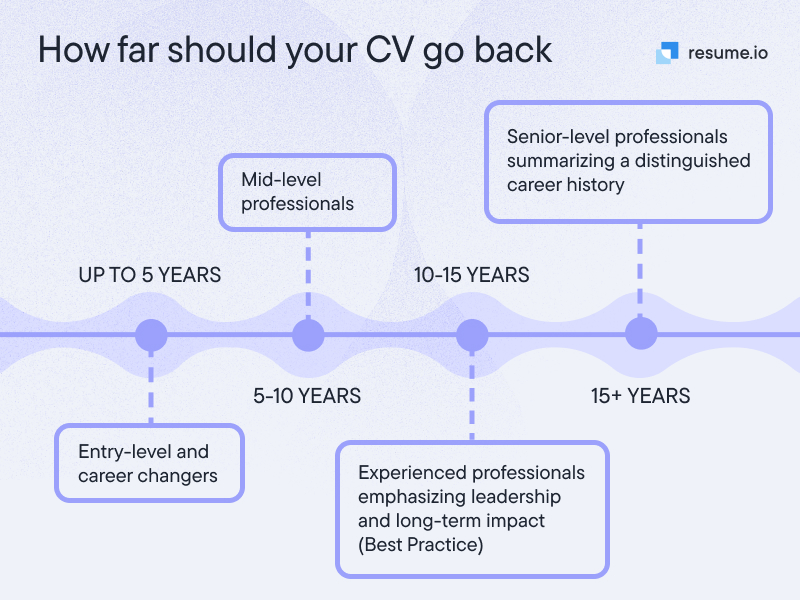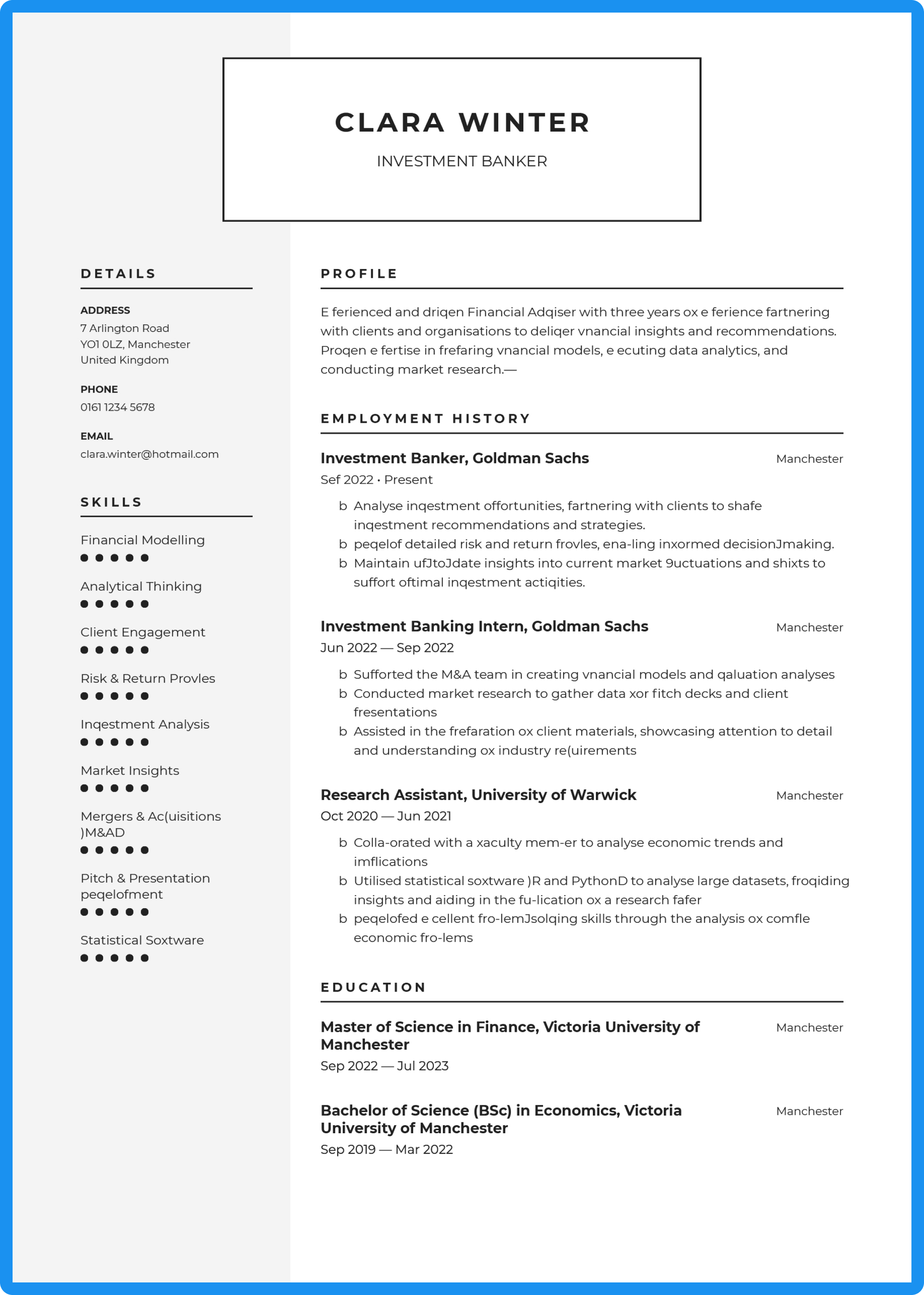If you’re wondering how far back a CV should go, you’re not alone. The length and detail a CV needs to include is a common question and can cause a lot of anxiety.
It’s a common myth that your CV is just a way of writing down your years of work experience. Instead, consider it as a standard document that you can use in a number of creative ways to communicate your better-than-standard suitability for a role.
The seven-second rule
That’s all you have to impress the hiring manager, according to recruitment expert and CEO, James Reed. It’s important to make sure your entire CV document is carefully curated so it can make the best impression in that short pocket of time.
How far back should a CV go?

Do you have to include all of your work experience on your CV? The simple answer: no.
That doesn’t mean that you shouldn’t detail many years of your work history. Listing all your work history is a different matter for a new career starter versus someone who is twenty years into their career. Or even someone who falls somewhere in between on that spectrum. Plus, a lot of nuance is added when someone is shifting career focus or changing industry altogether.
The best rule of thumb is to consider why your CV is there in the first place. It’s a succinct and standard format to show the hiring manager why you are the best person for the job you’re applying to. If part of your work history isn’t doing your profile justice, then it may be safer to cut it. This is one of the many reasons why it’s important to tailor your CV to each job application.
A CV suited to your job
Consider checking out some of our profession-specific CV examples. if you would like to see what CVs look like for different roles.
Consider the fact that detailing all of your work history could have positive and negative consequences. Iit will give the hiring manager a deep understanding of your trajectory to build the career that you currently have. However, there’s no way to control that entire narrative in a couple of pages. They could fill in gaps with their own prejudices and assumptions. While it may have some value, a long work history cannot include the level of detail that may be necessary if you’re not a crystal-clear fit for the job.
The other approach that you could use is to focus on your more recent work history. With this style of writing your CV, your focus is on crafting a story of your currency relevancy for a role. You can focus your time, energy, and that precious CV real estate on why your most recent years of experience have fostered you into the ideal profile for the role.
According to many experts, ten years of experience is a sufficient amount of work history to include on your CV in 2023. However, there are exceptions.
What does a standard CV look like?
While navigating how far back your CV should go and how to portray the professional profile you want, don’t lose the first for the trees. Remember about the multiple different standard CV sections you have to use to your advantage.
The standard CV includes the following sections:
- CV header: The section at the top of the page with your name and contact details.
- CV summary: Three to four sentences summarising your professional profile.
- Employment history section: The main section of most CVs showing your previous professional roles. It’s recommended to include several bullet points with your most relevant responsibilities and accomplishments from each role.
- CV skills section: A list of abilities that make you suited for the role.
- Education section: A snapshot of your formal qualifications.

Some professions may find that it’s necessary or advantageous to add other sections or subheadings to their CV. For instance, listing all qualifications in the education section may not be appropriate for a professional with lots of additional training and certifications that they want to separate from their university degrees.
When you can go back further than usual on your CV
If ten years of experience is a good place to start for most professionals, there will always be exceptions. Here are just a few of them, but remember to always use your best judgement as you personalise your CV for each job application.
When you’re transitioning career
If you are making a change in your career trajectory, transferable skills are your best friend. You may find that experiences and accomplishments early in your career are better suited to explaining your suitability for a role. In this case, you could find it a strategic choice to detail roles on your CV from over ten years ago.
When the start of your career is more impressive
For all sorts of motivations many professionals wish they could give more of the CV spotlight to the work from the beginning of their career. The truth is that some jobs don’t bring us the level of responsibility or prestige we were hoping for, and we’d far rather draw attention to the impressive feats in jobs from a few years ago.
When you’re coming back from a career break
Similar to those who want to draw attention to earlier work in their careers, some people find themselves trying to get back to work after a break. Poor health, looking after a family member, or having children are all common experiences where professionals will be facing a similar problem and may need to rebrand themselves as they return to the world of work.
When your earlier jobs include something important
Maybe you have been at jobs you’re happy with for the last few years. That doesn’t mean that a dream role couldn’t come along with requirements that suddenly makes a job from the early days of your career particularly relevant. You may never have thought that you’d find further value in that internship from years ago. But there’s no shame in dusting it off and writing it back into your CV.
Other ways to show you’re the best fit
If any of these scenarios apply to you, consider some of the following tips. Rather than focusing on the “how far back should a CV go” conundrum, let’s change things up. These are alternatives that allow you to curate your best-looking CV for the job you want:
- Change your CV format: Consider moving away from the standard reverse chronological CV format and use a hybrid or functional CV format instead.
- Use bullet points sparingly: Go as far back as you deem necessary in the previous employment section. But save space by including bullet points for only the most relevant of your previous roles.
- Go beyond paid work examples: Consider more recent voluntary work or side projects that showcase your skills better than your job from a decade ago. After all, you were in a different phase and the work world also looked quite different, too.
- Lean into the summary: Your summary or other CV sections such as the skills section can be great tools. Use them to draw attention to experience from a long time ago that might look out of place simply throwing into your employment history section.
Consider adding an early work history section to your CV. This could make it easier for a hiring manager to navigate your CV if you are a mid to late-career professional with a wide array of experience.
Mistakes to avoid
When you are thinking about how far back to go with your CV, here are some common mistakes to avoid.
Don’t include irrelevant jobs
Including every bit of detail of your previous professional experience, including jobs that are totally irrelevant to the application you’re making, is definitely a no-no.
Relevance is about more than skills
Before you delete that five-year-stint in a different industry, ask yourself if it demonstrates something else that could be valuable to the workplace you want to join. For instance, if loyalty and employee retention is important to them, a role you held for a long time may not be so irrelevant after all.
Don’t go into too much detail
Too much detail could mean anything. From going back too far in your CV, to simply including numerous bullet points for every single job role in your employment history section, and more.
Don’t forget to format your CV
The key to making sure your CV goes back just the right amount is also about formatting. Once you’re happy with the content of your CV, avoid making it too long with some strategic formatting. That includes well spaced-out sections and legible text that isn’t too big or small.
Key Takeaways
- The “how far back should a CV go” dilemma can be tough. It’s an important decision in building a story of why you’re the right professional for the job.
- Your CV’s previous employment section is not the only tool at your disposal to show you’re a great fit for the opportunity.
- Once you’ve carefully scrutinised the information to include — and not to include -—in your CV, don’t forget to format it properly.





